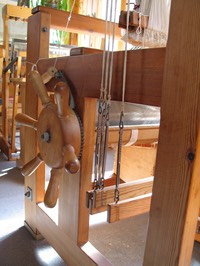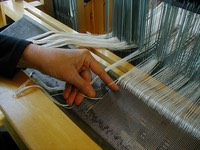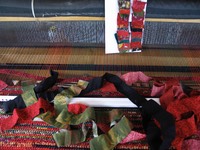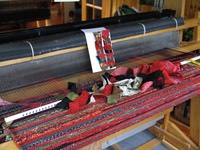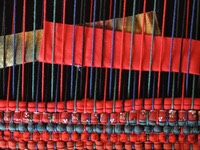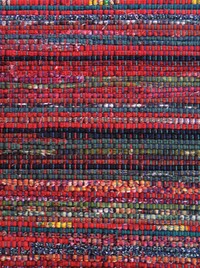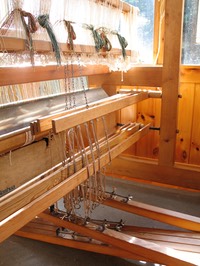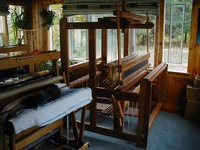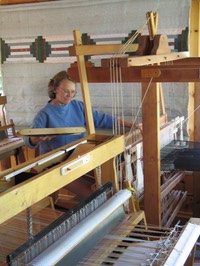Handweaving:
How does a loom work?
Weaving is done on a loom. Warp yarns are threaded on the loom and by a series of “tie ups” to foot controls or “treadles” the warp is manipulated so that a shuttle can be thrown between the raised and lowered threads. In my case, rag rugs require the weft be finger fed between the warp threads by hand without the use of a shuttle.
What does handwoven mean?
Weaving has historically been a process of making fabric from a natural fiber by spinning the fiber into yarn that can then be put on loom and shuttle to create cloth.
What is the difference between Handwoven and Handloomed?
In modern terminology there is a distinction between handwoven and handloomed. Handweaving is when the complete process is all done by hand. Handloomed is when the loom is prepared by hand but the actual weaving is mechanized.
How long does it take to weave a rug?
This is a hard question to answer.
It takes a lot of weaving experience to make a rug that is tight and straight. So, one answer is that it takes many years of practice to make one like these.
The other answer, the one that most people are really asking is how many hours of weaving does it take to make a given rug.
Before you can start weaving you have to prepare a warp and wind it onto the loom, then thread all the ends through two sets of eyes. Preparing the loom can take several days. Time weaving varies by the width of the rug being woven. For example, on a 2 ft wide rug I can weave a foot or two and hour; on a 5 ft wide rug I may only weave a few inches in an hour.
About Rag Rugs:
what are rag rugs ?
Rag Rugs resulted from a tradition of reusing old textiles. Historically, housewives would recycle worn clothing or bedding by tearing it into strips, sewing them together and winding it into balls, They would then take these balls of weft to the local weaver to be woven into rugs. In Canada the French tradition is to weave blankets.
Are there different kinds of Rag Rugs?
There are different traditions of rag weaving. It was so time consuming to make a textile that most cultures had a way to reuse worn fabrics. Early American rugs are generally smaller and thicker, more of a “scatter rug”. French Canadian blankets were an alternative to the quilt. My rugs are in the Scandinavian tradition. They are woven finer and are intended as carpets that can cover a whole room.
How are they made?
A strong warp yarn is chosen for durability and threaded on a loom. The collected strips of cloth are then woven into new textiles. If the strips are wide the textile will be heavy like a rug. If the strips are narrow the textile will be lighter weight like a blanket.
Where do you get your fabrics?
My rugs are made with recycled and new fabrics. Whenever possible I use fabrics that I find or have passed on to me. I also purchase cotton fabrics from mill end stores and yardgood stores. I wash them to pre-shrink and then cut them into 1 inch wide strips. Cutting the strips makes a smoother surface on the rug. Ripping the cloth causes it to be fuzzy.
How big can you weave them?
I can weave room size rugs. An individual rug is limited by the weaving width of any given loom, but several widths can be woven and stitched together to make a larger rug. The length is limited only by the Length of warp yarn that can be wound on the back beam of the loom. I have woven 22 ft long runners and 10 x 15 room sized rugs.
How small can you weave them?
I will weave as narrow as 18” in any length.
CARE:
How do I care for a rag rug?
You can wash and vacuum your rug.
Do I need a rug pad?
In a low traffic area a pad is not required. If you want to keep the rug in place there are pads available for any type of surface. I use the non-skid pad called “nomove” on wood, tile, or linoleum surfaces. There is a felted pad that you can use on top of another carpet. Pads are available at most flooring and carpet stores. They are sold by the linear foot.
Are they washable?
Yes, rugs that are smaller the 3 x5 or 2 x 6 runners can be washed on gentle in the washing machine. They should not be put through the dryer. My materials are pre washed to avoid shrinkage.
Larger rugs can be hand washed in a bathtub or outside in a large tub and rinsed with a hose. I dry mine over a railing on my deck.
Some of my customers report having them dry cleaned with good results.
Are they color fast?
To a great extent, yes, they are. Under normal circumstance they will hold color well. If, however, you are using a rug in a very bright room like a sun room I recommend using a UV protectant.
Are there any spray protectants you recommend?
Yes, I use a product called Fabric Shield. It is a soil repellant and also protects against sun damage.
Do they wear well?
Handwoven rag rugs are very sturdy and will hold up to a lot of wear. You can prolong the life of a rug that is in a high traffic area by washing it regularly so that grit does not wear the fibers.
How long do they last?
I have rugs in my home that are over 15 years old. When I show my rugs at a craft show I am often approached by people who still have rugs in their families that were woven by ancestors a generation or two back.
Are they reversible?
My rag rugs are woven in a “plain weave” and are completely reversible. I attach a label on each rug that is handmade and in a similar fabric to the rug, it is attractive and can be laid face up or down.
About the Designs:
Do you have certain designs to choose from?
There are five basic patterns that I weave currently. I have named them, Cottage Garden, Stonybrook, Arrowhead, Argyle and Hit-or-Miss. There are descriptions and pictures of THE PATTERNS in different color combinations and sizes on this website.
Can you weave other designs?
Yes, I can design a custom rug to match your decor. If you have a design you would like me to weave I can give you a quote.
About Custom Ordering:
What information do you need for a custom order?
Whether, you choose one of my designs or request a custom design I will need guidelines.
A client can request, size, color, pattern finish, etc.
A visit to the local paint store can be a good source of swatches of the colors you want in the rug. You can also send samples of upholstery fabrics, tile, etc.
I will select fabrics and yarns to match your colors, and send you a design for approval.
What does a design include?
A design will include: a schematic of the warp pattern, and samples of the warp yarns. A selection of cloth strips to give a sense of color palette will also be attached. A commission agreement will quote the prices.
How do I approve a design?
Sign a copy of the commission agreement and return it with a 50% deposit. I will then schedule the weaving and let you know when you can expect it to be finished.
How long does it take if I order a custom rug?
It usually takes 8-10 weeks for a custom order. Large rugs that are woven in panels it will take longer.
Pricing?
Rugs up to 4 ft. wide are $32-50.00 a square foot. Prices vary for larger rugs depending on complexity of design.
About the artisan:
Where did you learn to weave?
I learned to weave in College, at the Mass. College of Art in Boston, in 1978. I purchased my first loom in 1980 and have been weaving ever since.
How long have you been weaving?
I began a self-employed weaving venture in 1980. My first weavings were yardage's for clothing. My background was in fashion and costume design and I began with a line of clothing that I sold to boutiques and children's shops.
After ten years of weaving and sewing clothing, I discovered rug weaving. In 1990 I began weaving rugs seriously and started showing them at craft shows. Over the past 15 years I have perfected the technique and am focused on improving my skill with each rug I weave.
Thank-you for visiting the FAQ page.
If you have any more questions please email me. I will be happy to answer you.
Hillary
email us: hutton@huttonstudios.com

